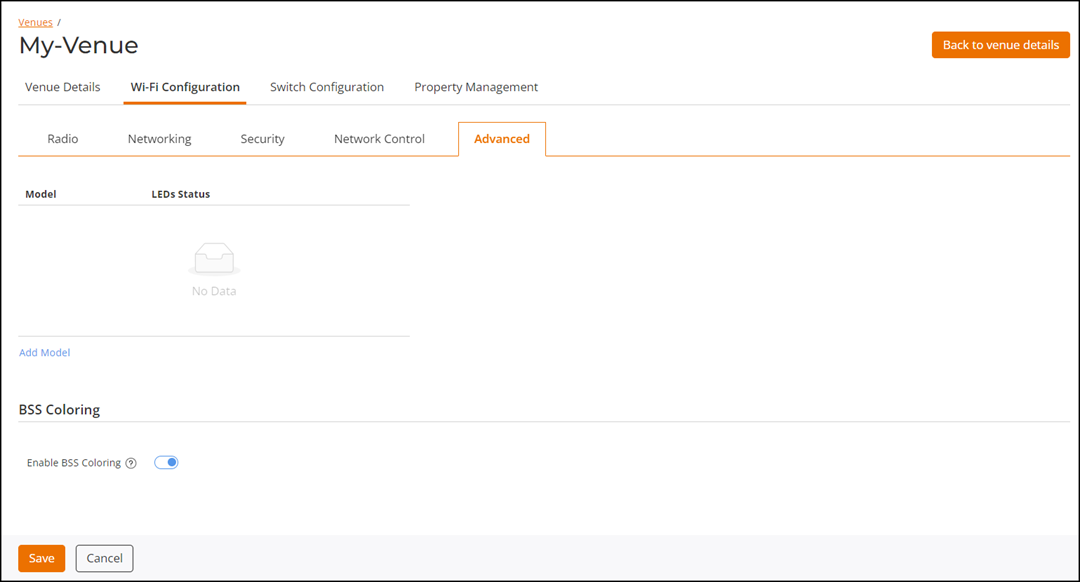Advanced Settings
Available in the Wi-Fi Configuration tab for a venue, the Advanced sub-tab allows you to enable or disable the LEDs and USB ports for specific AP models, and enable or disable the BSS Coloring feature.
-
On the navigation bar, click
Venues.
The Venues page is displayed.
- Click the check box for the specific Venue name, then click Edit. Alternatively, click the specific Venue name, then click Configure.
-
Select the Wi-Fi
Configuration > Advanced tab.
The Advanced Settings tab is displayed.
Venue Wi-Fi Configuration: Advanced Tab 
- Click Add Model, select an AP model from the Model drop-down list.
- (Optional) Toggle the LEDs Status switch, if desired. By default, the LEDs Status is enabled.
-
(Optional) Click the
 icon to delete a model.
icon to delete a model.
-
(Optional) Toggle Access Point USB Support to enable to
USB interface in the AP model.
This option is only available for AP models that have a USB interface.
Enable or disable the USB port for IoT-connected devices. When you enable it, the port supports IoT device connectivity and data transfer.Note: For PoE APs, you cannot use the USB port with PoE 802.3af or 802.3at because of insufficient power. -
Toggle the BSS Coloring switch to enable or disable the
Basic Service Set (BSS) feature. By default, this feature is enabled. BSS
Coloring marks shared frequencies to allow 802.11ax access points to determine
whether simultaneous use of spectrum is permissible. This technology reduces
interference due to congestion and ensures consistent service to multiple
connected devices in high-density environments. This configuration is now
supported at the overall venue and individual AP level.
Click the
 icon to view the feature synopsis and the supported AP model families
(denoted by their applicable IEEE 802.11 standard). Click See the compatibility
requirements to view the compatibility requirement
information, such as the number of current incompatible APs, the minimum
required version, and the supported AP model families (denoted by their
applicable IEEE 802.11 standard).Note: If you disable or enable one of the features that depends on AP compatibility, then RUCKUS One automatically checks AP compatibility as part of the venue or network configuration update. Click the
icon to view the feature synopsis and the supported AP model families
(denoted by their applicable IEEE 802.11 standard). Click See the compatibility
requirements to view the compatibility requirement
information, such as the number of current incompatible APs, the minimum
required version, and the supported AP model families (denoted by their
applicable IEEE 802.11 standard).Note: If you disable or enable one of the features that depends on AP compatibility, then RUCKUS One automatically checks AP compatibility as part of the venue or network configuration update. Click the icon in the upper-right corner of the UI
header, then click the related network or venue settings activity to view
the Activity
Details. Here you can do the following:
icon in the upper-right corner of the UI
header, then click the related network or venue settings activity to view
the Activity
Details. Here you can do the following: - View the status of the resulting AP compatibility check.
- Click See incompatible report to view a list of the incompatible APs.
- In Access Point Management VLAN, set the Management VLAN ID value from 1 to 4094. Ensure that you configure the network switches with the corresponding settings.
- The AP Auto-Reboot on GW Timeout is configured to reboot the AP. An AP is automatically rebooted if it cannot reach its gateway (GW) or controller within a specified time frame. This is a safeguard mechanism to ensure network stability and connectivity. If the AP loses connection to the GW or controller, it will attempt to reboot itself in hopes of re-establishing the connection. By enabling the Gateway Connection Monitor, you can select how long the AP will wait before rebooting if it cannot reach the gateway. By enabling the Controller Connection Monitor, you can select how long the AP will wait before rebooting if it cannot reach the controller.
- Click Save.